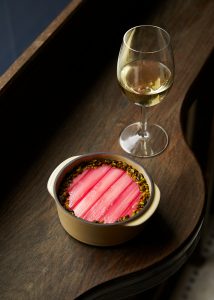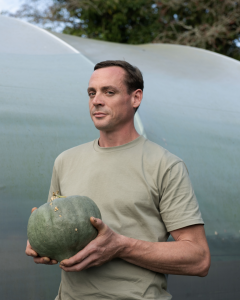The accolade-laden head chef at Mayfair’s St. James’s Hotel and Club reflects on formative kitchens and a childhood surrounded by nature

Seven Park Place is one of the smallest Michelin-starred restaurants in Europe. It’s size, however, belies the hydra-headed responsibilities of William Drabble, who oversees all aspects of dining at Mayfair’s St. James’s Hotel and Club, where the restaurant sits. Private dining, afternoon tea, room service, all day dining – the hectic amount of covers and demands would give any normal chef a headache, but Drabble is an exceptional one. Leaning on decade-long relationships with the best of British suppliers, he approaches seasonal ingredients through a modern-French lens, a perspective refined at significant placements at Aubergine, Grasmere Country House Hotel and Pied à Terre. In each of these kitchens stars were either won or maintained, and Seven Park Place is no different, holding one Michelin and four AA Rosettes. Drabble credits his love of food to two early influences – his grandmother, who was herself a cook in a country estate, and his rural Norfolk upbringing surrounded by flora and fauna. This love is still very much present across his seasonally changing ‘Discovery’ and ‘Gourmand’ menus, with highlights including seared Foie Gras, saddle of Red Deer, Jerusalem artichokes, celeriac and apple purée, and pan-fried monkfish.
Port caught up with the head chef to discuss a childhood surrounded by fresh produce, formative kitchens, and the factors more important than accolades.

How have you been during the pandemic? Were you able to take advantage of a slight pause in service and stand still for a second?
Yes, we got time to think and reflect, but now we’re back at it. It’s a reset, isn’t it?
From what I’ve read your grandmother, who was a cook herself, had a big impact on your love of food. Did you cook alongside her at all?
It was more that I was inspired by her tales of service, putting coal into the stove, all very traditional. She worked for the Fitzwilliam family in Wentworth Woodhouse, learning her trade in the 1930s. She used to tell me all about the temperamental chefs in those days.
So chefs have always been temperamental?
It sounds like it!
Is there a dish that encapsulates her?
She was a good Yorkshire girl so it has to be roast beef with Yorkshire pudding and all the trimmings.
Another factor that shaped you seems to be your move to Norfolk way back when – how did you begin to see food differently, in a rural setting?
I went from Liverpool, where I was playing football in the street, to a tiny cottage where the nearest neighbour was a mile away. I remember the first morning after we moved opening the back door and encountering a cow that had escaped a field, eating our grass. I used to help milk the cattle with the farmer and everybody grew their own produce, giving away any surplus for free – fresh broad beans, tomatoes, apples – you name it, they would grow it. Tasting peas from the pod, or strawberries that have just been picked… you couldn’t get it any fresher. I was nine years old, a very influential age to be exposed to that world.

Prior to Seven Park Place you’ve worked in some noteworthy establishments – is there a kitchen that was particularly formative for you, or an individual?
Every kitchen you work in has an influence and often you can look back at your food and pinpoint where a dish might have come from. I believe if you want to learn something, you need to stay somewhere. Over a longer period, you get to know how and why the operation works. I did three years at Norwich City College and had a wonderful lecturer – who I still talk to – called Martin Jermey. He hooked me up with my first job, putting me in touch with Keith Mitchell who was at the Grand Hotel in Eastbourne, and I ended up working there for three and a half years. The prior year he’d done the exact same thing with Tom Aikens, so we worked there together.
I then went to the Capital Hotel in Knightsbridge with Philip Britten and the food style was very different to what I’d been cooking. We used to go down the market and buy all the vegetables at five o’clock in the morning, set ourselves up for the day. Afterwards I worked at Chez Nico – run by Nico Ladenis – and learnt the value of simplicity, before teaming up with Tom at Pied à Terre. He’d asked whether I wanted to be his number two and have some fun – it was the hardest kitchen I’d ever been in. The pressure was so intense. Full lunch, full dinner, just taken over from a two star chef, pushing everything to the limit. Tom was 27 at the time, I was 25. We pushed and pushed and pushed along with everybody else. Tom’s an incredible cook, he squeezes out every ounce of flavor. It was tough, but the amount you learnt was phenomenal.

Those high-pressure crucibles can definitely make or break people – how do you like to run your kitchen?
I like a calm kitchen, quite quiet so people can concentrate on what they’re doing. You need a little bit of pressure there to motivate them, but people are here to learn and I’m there to teach them. The more I can teach them, the more strings to our bow, the more they can see. By doing that, I can retain staff better because there’s a continuous learning experience.
You’re not having a high churn, starting over, constantly bringing people up to speed.
Yes, by that you also maintain consistency and improve your standards. I don’t like to particularly buy anything in, so we make our own chocolates, ice cream, bread, do our own butchery, fish prep – the only way you can do that is with trained staff.
What is your process for creating a dish?
It all starts with talking to suppliers. I’m always talking to them, finding what the current best ingredients are – whether that’s some great celeriac, chestnuts, wild mushrooms. I’ve been working with the butcher for 25 years, the fishmonger, 30 years. They know what I want, shall we say. Find the good ingredients and don’t mess around with them, let them speak for themselves.
As we move from Autumn to Winter, what’s on the menu and what do you love cooking with at this time of the year?
I’m enjoying scallops with citrus fruit, which are both very good at the moment. Wild venison from Cumbria, turbot from the South coast, native lobster with cauliflower.
What do accolades like Michelin stars mean to you? You’ve won and maintained a few. Are they helpful markers, or are you more focused on how you personally define excellence?
Any chef who says they don’t care about the accolades would be a liar. At the end of the day, they do matter. But they’re not the people who pay your wages. It’s the customers that come through the door. The most important thing is to look after them, make sure they get a great experience. If you turn them into regulars your business is working. Then you can progress on all those things that make it excellent.




